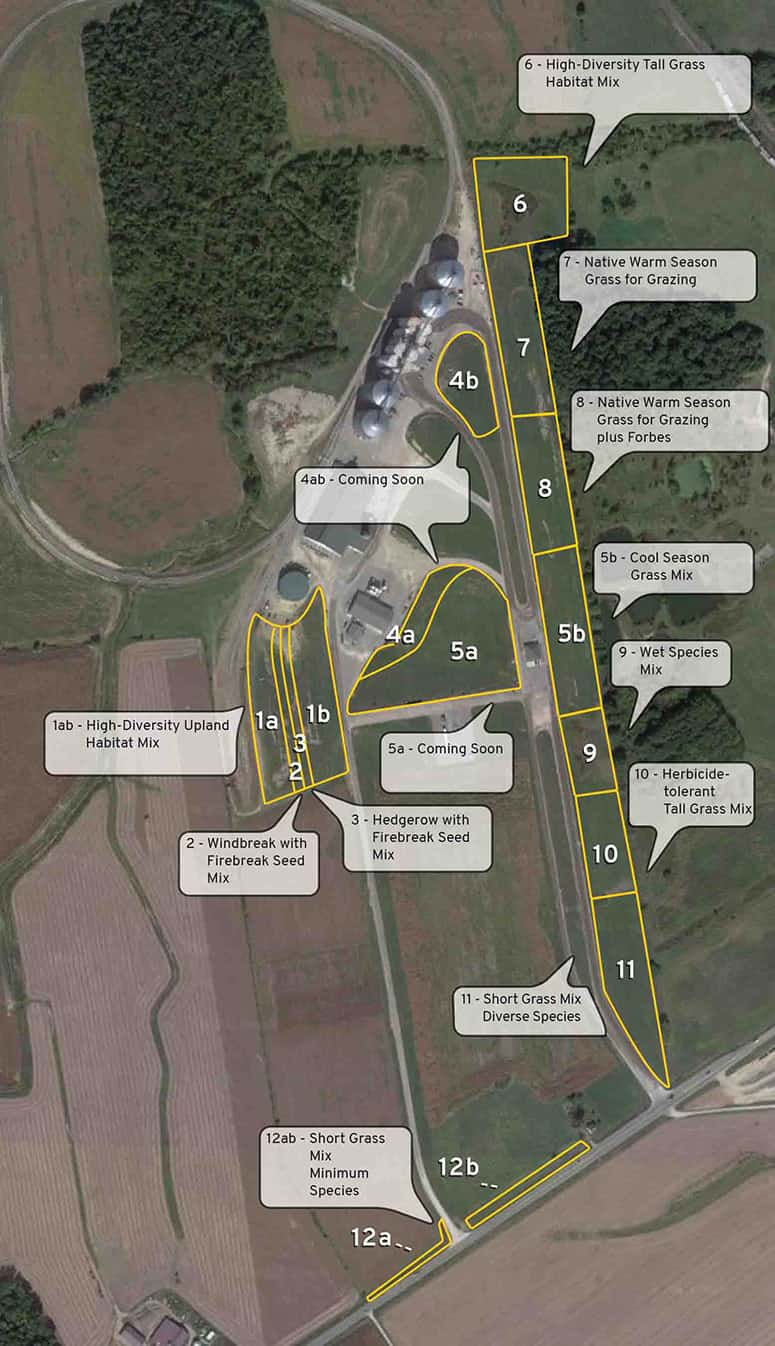MAC Conservation Demo Plots
As part of our mission to provide value to our members and customers through individualized solutions, a new project is commencing at our Marysville Ag Campus in Marysville, Ohio. We are transitioning 25 acres of turf into a variety of conservation plantings. Most farms have areas that do not provide a return on investment, such as field edges and wet spots, but it can be difficult to decide what to do with these areas without being able to see the options on the ground. To help our growers better understand these options and what goes into them, we will be installing 12 different conservation plantings. Please contact Sarah Moore at smoore@heritagecooperative.com or your Heritage agronomist for any questions or to see the demo plots up close.
Interactive map – click on the demo plot description for complete details on each plot including species list.
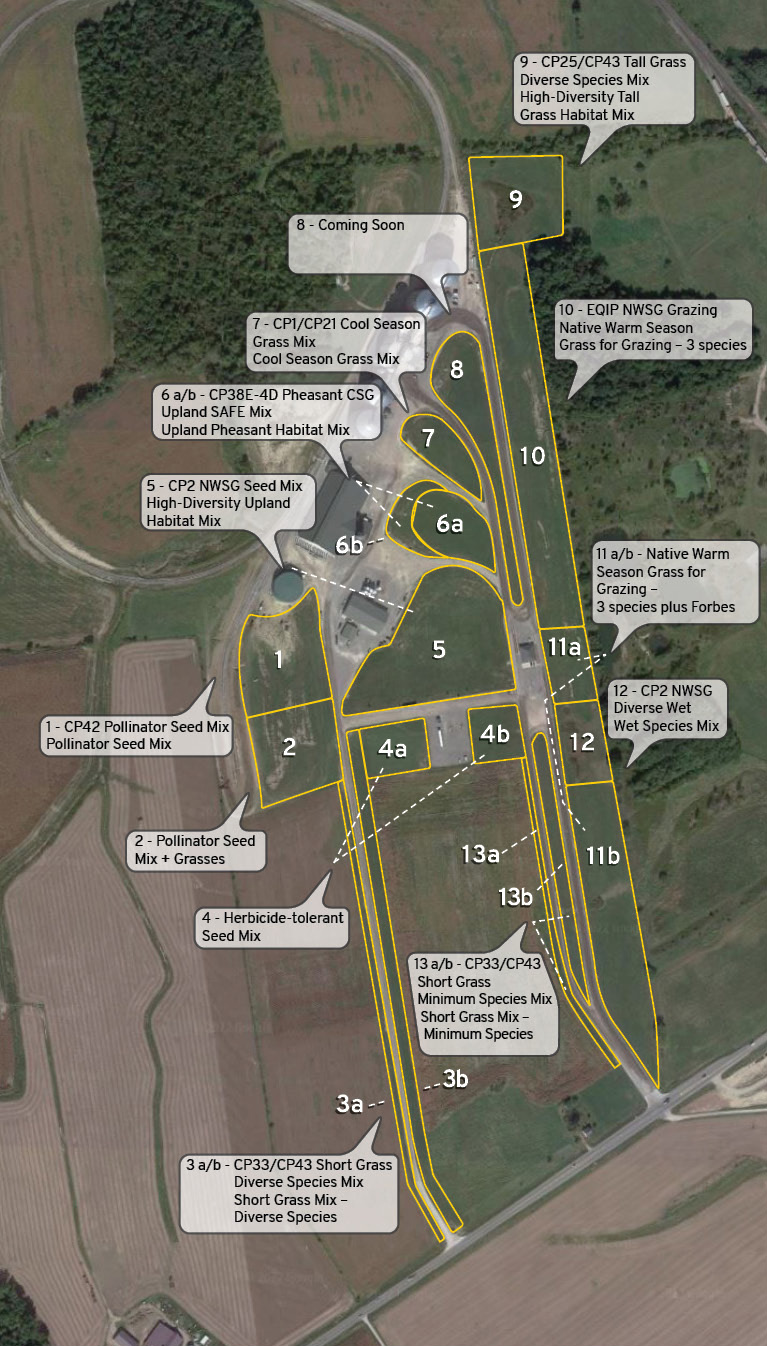

Name
Short Grass Mix – Minimum Species
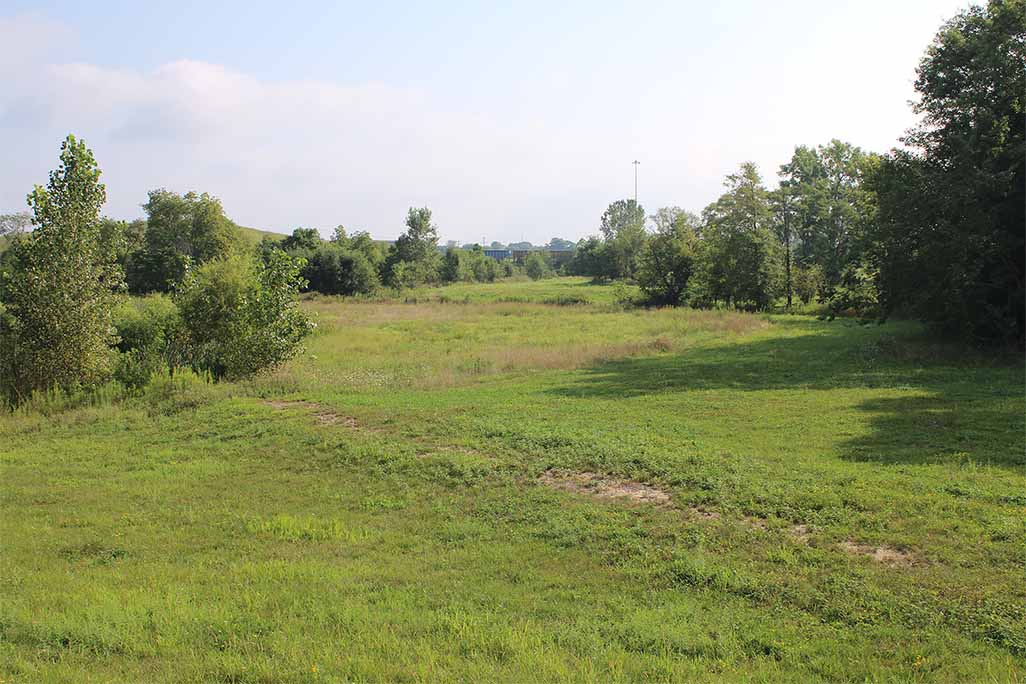
Description
With 37 species, this mix is well-rounded, and provides excellent habitat for a wide variety of upland species. Almost identical to the High-Diversity Upland Habitat Mix; the substitution of Prairie Junegrass for Big Bluestem allows this mix to meet NRCS EQIP Wildlife Tall Grass Seeding Standards, as well as OH CRP CP25, CP43 standards.
Species List
Grasses
- Autumn Bentgrass
- Big Bluestem
- Sideoats Grama
- Fowl manna grass
- Switchgrass
- Little Bluestem
- Purple Top
Legumes
- Partridge Pea
- Illinois Bundleflower
- Alfalfa
- Alsike Clover
- Crimson Clover
- Ladino Clover
Forbes/Wildflowers
- Yarrow
- Common Milkweed
- Swamp Milkweed
- Lanceleaf Coreopsis
- Plains Coreopsis
- Purple Coneflower
- False Sunflower
- Great Blue Lobelia
- Wild Bergamot
- Evening primrose
- Stiff Goldenrod
- Foxglove Beardtongue
- Narrowleaf Mountain Mint
- Mountain Mint
- Prairie Coneflower
- Grayheaded Coneflower
- Black-eyed Susan
- Brown-eyed Susan
- Gray Goldenrod
- Smooth Blue Aster
- New England Aster
- Frost Aster
- Hoary Vervain
- Wingstem
- Culver's Root
Name
High-Diversity Tall Grass Habitat Mix

Description
With 37 species, this mix is well-rounded, and provides excellent habitat for a wide variety of upland species. Almost identical to the High-Diversity Upland Habitat Mix; the substitution of Prairie Junegrass for Big Bluestem allows this mix to meet NRCS EQIP Wildlife Tall Grass Seeding Standards, as well as OH CRP CP25, CP43 standards.
Species List
Grasses
- Autumn Bentgrass
- Big Bluestem
- Sideoats Grama
- Fowl manna grass
- Switchgrass
- Little Bluestem
- Purple Top
Legumes
- Partridge Pea
- Illinois Bundleflower
- Alfalfa
- Alsike Clover
- Crimson Clover
- Ladino Clover
Forbes/Wildflowers
- Yarrow
- Common Milkweed
- Swamp Milkweed
- Lanceleaf Coreopsis
- Plains Coreopsis
- Purple Coneflower
- False Sunflower
- Great Blue Lobelia
- Wild Bergamot
- Evening primrose
- Stiff Goldenrod
- Foxglove Beardtongue
- Narrowleaf Mountain Mint
- Mountain Mint
- Prairie Coneflower
- Grayheaded Coneflower
- Black-eyed Susan
- Brown-eyed Susan
- Gray Goldenrod
- Smooth Blue Aster
- New England Aster
- Frost Aster
- Hoary Vervain
- Wingstem
- Culver's Root
3
Name
Native Warm Season Grass for Grazing
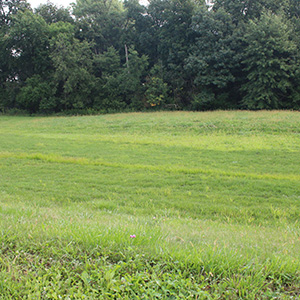
Description
Native warm season grasses are an excellent addition to any grazing operation. They produce equivalent biomass and nutritional value to typical cool season forages, with the added benefit of thriving during the ‘summer slump,’ when cool season grasses go dormant. With proper establishment, these pastures can be grazed one year after planting. It is recommended to have 15-25% of pasture planted to native warm season grasses to allow cool season grass pastures to rest while avoiding the need to purchase hay.
Species List
Grasses
- Big Bluestem
- Little Bluestem
- Indiangrass
Legumes
Forbes/Wildflowers
5
6
Name
Coming Soon
Description
Coming Soon
Species List
Grasses
Coming Soon
Legumes
Coming Soon
Forbes/Wildflowers
Coming Soon
8
Name
Native Warm Season Grass for Grazing – plus Forbes
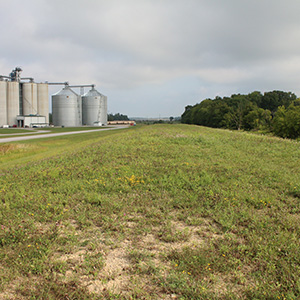
Description
Native warm season grasses are an excellent addition to any grazing operation. They produce equivalent biomass and nutritional value to typical cool season forages, with the added benefit of thriving during the ‘summer slump,’ when cool season grasses go dormant. With proper establishment, these pastures can be grazed one year after planting. It is recommended to have 15-25% of pasture planted to native warm season grasses to allow cool season grass pastures to rest while avoiding the need to purchase hay.
By adding forbes to the mix, forage protein is increased and the stand is able to provide better habitat for wildlife than grasses alone. If you’re looking for a multi-functional planting, this mix is a great choice.Species List
Grasses
- Big Bluestem
- Little Bluestem
- Indiangrass
Legumes
- Partridge Pea
- Alsike Clover
- Crimson Clover
- Illinois Bundleflower
Forbes/Wildflowers
- Purple Coneflower
- Prairie Coneflower
- Black-eyed Susan
Name
Windbreak with Firebreak Seed Mix
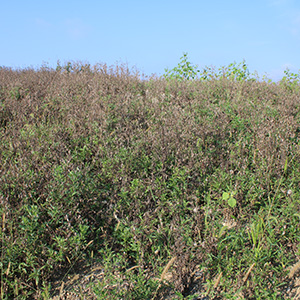
Description
Windbreaks consist of rows of trees planted on the leeward side of a field to protect crops from wind damage. This windbreak is filled with a variety of native species that can tolerate the dense clay soil in this area.
Fire is a natural part of prairie ecosystems. However, this is not the case for many of our native trees and shrubs. When planting windbreaks and hedgerows, it is important to plant a ground cover that is not prone to burning that can serve as a buffer against fire damage.Species List
Grasses
Legumes
- Alfalfa
- Alsike Clover
- Crimson Clover
- Ladino Clover
Forbes/Wildflowers
Trees/Shrubs
- Pin Oak
- Sycamore
- Red Maple
- Silver Maple
- Kentucky Coffeetree
- Eastern Red Cedar
11
Name
Cool Season Grass Mix
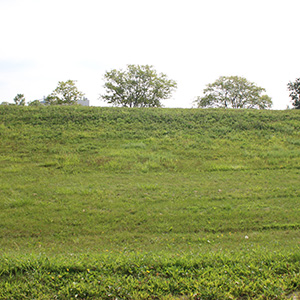
Description
A simple mix, these species tend to stay short (2-3 ft in height), and as such are great for areas that need to maintain a sightline.
This mix meets OH CRP NWSG CP1, CP4D, CP9, CP21, CP29,CP23, CP23A, CP27/28, CP39, CP40 - Seeding Standards.
Species List
Grasses
- Orchardgrass
- Timothy
Legumes
- Alfalfa (VNS)
- Alsike Clover
- Crimson Clover
- Ladino Clover
Forbes/Wildflowers
- Common Milkweed
- Swamp Milkweed
- Black-eyed Susan
Name
Wet Species Mix
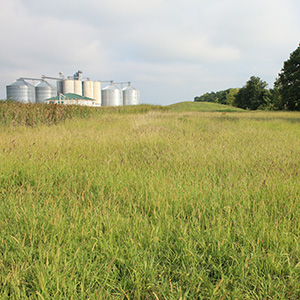
Description
This 39 species mix is tailored to soils that are frequently flooded and hold water. In particular, sedges do well where their roots stay moist.
This mix meets OH CRP CP2, CP4D, CP9, CP21, CP29,CP23, CP23A, CP27/28, CP39, CP40 Diverse Wet Seeding Standards.
Species List
Grasses
- Big Bluestem
- Virginia Wildrye
- Fowl manna grass
- Switchgrass
- Little Bluestem
- Woolgrass
- Fox Sedge
- Common Rush
- Green Bulrush
Legumes
- Partridge Pea
- Alsike Clover
- Crimson Clover
- Ladino Clover
Forbes/Wildflowers
- Yarrow
- Common Milkweed
- Swamp Milkweed
- Plains Coreopsis
- Flat-topped Aster
- Common Boneset
- Spotted Joe-Pye Weed
- Sneezeweed
- Cardinal Flower
- Great Blue Lobelia
- Seedbox
- Wild Bergamot
- Evening primrose
- Stiff Goldenrod
- Foxglove Beardtongue
- Narrowleaf Mountain Mint
- Mountain Mint
- Prairie Coneflower
- Grayheaded Coneflower
- Black-eyed Susan
- Brown-eyed Susan
- Smooth Blue Aster
- New England Aster
- Frost Aster
- Blue Vervain
- Wingstem
14
15
Name
High-Diversity Upland Habitat Mix
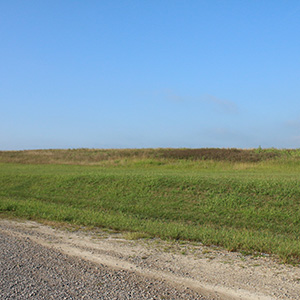
Description
With 37 species, this mix is well-rounded, and provides excellent habitat for a wide variety of upland species.
This mix meets OH CRP NWSG CP2, CP4D, CP9, CP21, CP29,CP23, CP23A, CP27/28, CP39, CP40 and NRCS 420 Wildlife - Diverse seeding standards.
Species List
Grasses
- Autumn Bentgrass
- Sideoats Grama
- Fowl manna grass
- Switchgrass
- Prairie Junegrass
- Little Bluestem
- Purple Top
Legumes
- Partridge Pea
- Illinois Bundleflower
- Alfalfa
- Alsike Clover
- Crimson Clover
- Ladino Clover
Forbes/Wildflowers
- Yarrow
- Common Milkweed
- Swamp Milkweed
- Lanceleaf Coreopsis
- Plains Coreopsis
- Purple Coneflower
- False Sunflower
- Wild Bergamot
- Evening primrose
- Stiff Goldenrod
- Foxglove Beardtongue
- Narrowleaf Mountain Mint
- Mountain Mint
- Prairie Coneflower
- Grayheaded Coneflower
- Black-eyed Susan
- Brown-eyed Susan
- Gray Goldenrod
- Smooth Blue Aster
- New England Aster
- Frost Aster
- Hoary Vervain
- Wingstem
- Culver's Root
Name
Short Grass Mix – Diverse Species

Description
Some native prairie grasses can grow to over 6 ft tall, which can be tough to manage, especially as plantings get close to roadways. This mix provides an alternative option filled with native grasses that max out at 3-4 ft tall.
The more diversity you have, the wider variety of wildlife you can accommodate. Compare this planting to the Short Grass Mix – Minimum Species.This mix meets OH CRP CP33, CP43 Short Grass Minimum Species Seeding Standards.
Species List
Grasses
- Autumn Bentgrass
- Sideoats Grama
- Fowl manna grass
- Little Bluestem
- Purple Top
- Switchgrass
Legumes
- Partridge Pea
- Illinois Bundleflower
- Alfalfa
- Crimson Clover
- Ladino Clover
- Alsike Clover
Forbes/Wildflowers
- Yarrow
- Common Milkweed
- Swamp Milkweed
- Lanceleaf Coreopsis
- Plains Coreopsis
- Purple Coneflower
- False Sunflower
- Great Blue Lobelia
- Wild Bergamot
- Evening primrose
- Stiff Goldenrod
- Foxglove Beardtongue
- Narrowleaf Mountain Mint
- Mountain Mint
- Prairie Coneflower
- Grayheaded Coneflower
- Black-eyed Susan
- Brown-eyed Susan
- Gray Goldenrod
- Smooth Blue Aster
- New England Aster
- Frost Aster
- Hoary Vervain
- Wingstem
- Culver's Root
Name
Coming Soon
Description
Coming Soon
Species List
Grasses
Coming Soon
Legumes
Coming Soon
Forbes/Wildflowers
Coming Soon
Name
Hedgerow with Firebreak Seed Mix

Description
Hedgerows are planted along forest edges and windbreaks with short woody species. Along forests, this provides what’s known as an ‘edge feathering’ effect, which allows for a softer transition between forests and fields. This creates a diverse habitat that can support a wide variety of wildlife species and reduces the negative yield impact suffered by crops that directly abut wooded areas. When used in conjunction with trees in a windbreak, it increases the width of the windbreak and makes it even more effective.
Fire is a natural part of prairie ecosystems. However, this is not the case for many of our native trees and shrubs. When planting windbreaks and hedgerows, it is important to plant a ground cover that is not prone to burning that can serve as a buffer against fire damage.Species List
Grasses
Legumes
- Alfalfa
- Alsike Clover
- Crimson Clover
- Ladino Clover
Forbes/Wildflowers
Trees/Shrubs
- Common Chokecherry
- Black Chokecherry
- American Plum
- Arrowood viburnum
- American Elderberry
- Sargent Crabapple
- Redosier Dogwood
Name
Herbicide-tolerant Tall Grass Mix
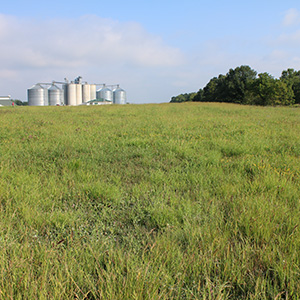
Description
This mix is filled with wildflowers that are tolerant to the herbicides Plateau and Milestone, which are frequently used to manage undesirable weeds after native plants have already emerged.
Species List
Grasses
- Big Bluestem
- Sideoats grama
- Switchgrass
- Little Bluestem
- Indiangrass
Legumes
- Partridge Pea
- Illinois Bundleflower
- Alsike Clover
- Crimson Clover
- Ladino Clover
Forbes/Wildflowers
- Common Milkweed
- Swamp Milkweed
- Lanceleaf Coreopsis
- Plains Coreopsis
- Purple Coneflower
- False Sunflower
- Wild Bergamot
- Evening primrose
- Stiff Goldenrod
- Foxglove Beardtongue
- Narrowleaf Mountain Mint
- Grayheaded Coneflower
- Black-eyed Susan
- Brown-eyed Susan
- Cup Plant
- Smooth Blue Aster
- New England Aster
- Hoary Vervain
- Culver's Root
- Golden Alexander
21
22
